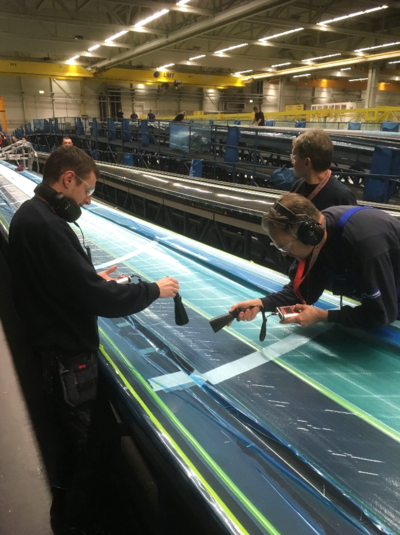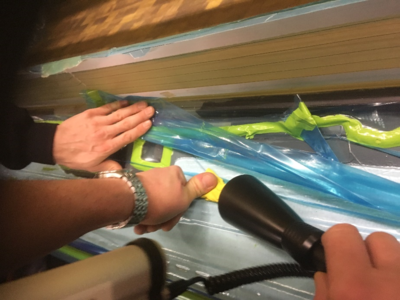Quality Control during the Manufacture of Fiber Composite Components
How to benefit from Ultrasonic Leak Detection during the Vacuum Infusion Process
Do you have any questions?
Feel free to contact us! We will be happy to help you.



Figure 1: Leak localization using ultrasound testing technology during the filling process
Composite materials are becoming increasingly important in the industrial sector due to their material properties. The manufacture of components from CFRP and GFRP often uses the vacuum infusion process. An example of a component produced on this way is the rotor blades used on wind turbines.
Modern wind turbines are being fitted with larger and larger rotor blades, in order to increase energy generation and optimize the plants. The rotor blades must be able to withstand heavy loads. This requires an efficient production process that also meets the high quality requirements.
During the manufacture of rotor blades, the structural mold is lined with composites and reinforcement materials. In a subsequent process, the mold is sealed with film, the vacuum is applied (evacuation) and the mold is filled with resin while the vacuum is maintained. Any leaks in the film during this process can lead to structural faults. For example, any areas that are not impregnated can have a negative impact on the durability of the rotor blade.
Leaking areas create detectable noises in the ultrasonic range through the ingress of air. Therefore, using ultrasound testing technology, these leaks can be found during the filling process and be eliminated before the resin is hardened. Costly reworking or follow-up damage during operation is avoided.

Figure 2: Sealing a leak after precise localization
The SONAPHONE Pocket ultrasound testing devices from SONOTEC help manufacturers to detect leaks and provide:
Feel free to contact us! We will be happy to help you.

Some cookies used here help to market our offer, while others are required. By clicking on "Agree" you consent to this use of data. Further information can be found under Privacy and the Imprint. Your consent also includes consent pursuant to Art. 49 (1) a) DSGVO to the transfer of certain data to third countries with a possibly insufficient level of data protection (e.g. United States of America). By clicking on the "Reject cookies" link, you can reject your consent or adjust it under Settings.